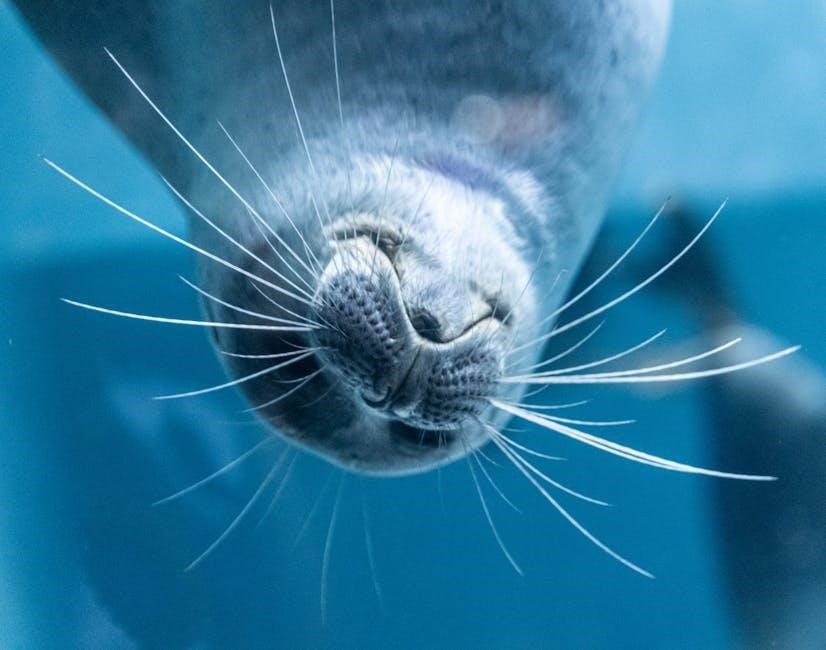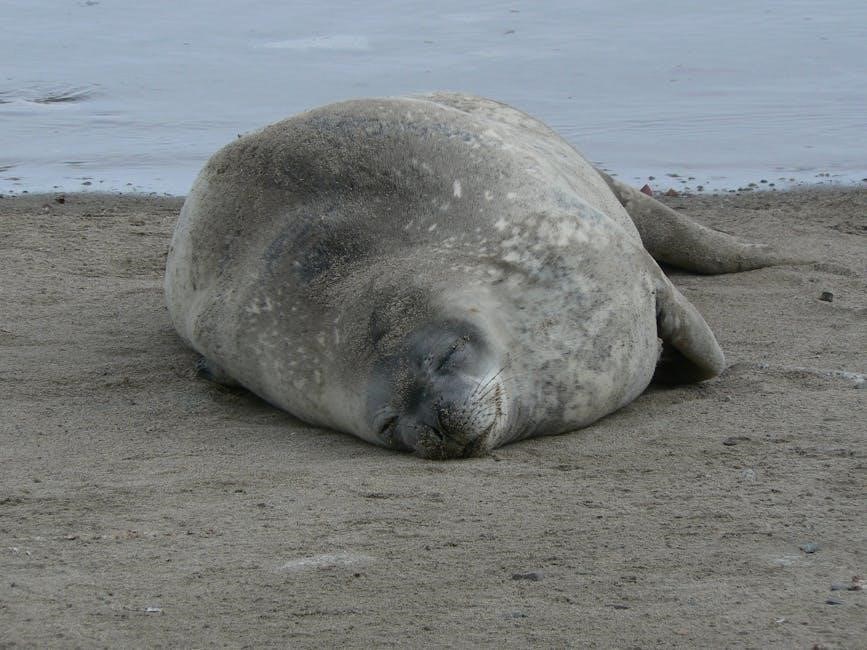Valve guides and seals are essential engine components, ensuring proper valve operation, preventing oil leakage, and maintaining compression․ They are made from durable materials and require regular maintenance․

Functions of Valve Guides
Valve guides play a critical role in engine operation, ensuring proper valve stem alignment, heat dissipation, and preventing oil leakage․ They support valve movement and maintain engine efficiency․
1․1 Guiding the Valve Stem
Valve guides ensure the valve stem moves smoothly and accurately within the cylinder head․ They maintain proper alignment, preventing sideways motion that could cause wear or damage․ Made from durable materials like steel or bronze, guides are precisely fitted to the valve stem, ensuring consistent operation․ Proper fitment is crucial to avoid leakage and maintain engine performance․ Guides also help in conducting heat away from the valve stem, contributing to overall engine efficiency and longevity․
1․2 Heat Dissipation
Valve guides play a critical role in heat dissipation, particularly for exhaust valves․ They transfer heat generated during combustion from the valve stem to the cylinder head․ This prevents overheating, which could damage the valve or surrounding components․ Materials like steel or bronze are often used for their thermal conductivity․ Effective heat dissipation ensures consistent engine performance, prevents warping, and extends the lifespan of the valve train components․ Proper cooling is essential for maintaining engine efficiency and reliability․
1․3 Maintaining Valve Alignment
Valve guides ensure proper alignment of the valve stem, preventing misalignment that could disrupt engine operation․ They act as a precise pathway for the valve stem, guiding it smoothly during opening and closing․ Misaligned valves can lead to poor sealing, reduced performance, and potential engine damage․ Durable materials and precise manufacturing ensure long-term alignment accuracy, which is crucial for maintaining efficient combustion and engine reliability over time․

Functions of Valve Seals
Valve seals prevent oil leakage, control lubrication flow, and ensure proper compression by forming a tight barrier between the valve stem and guide, maintaining engine efficiency and performance․
2․1 Preventing Oil Leakage
Valve seals are crucial in preventing oil leakage by forming a tight barrier between the valve stem and guide․ This prevents oil from entering the combustion chamber, ensuring proper lubrication control and maintaining engine compression․ Effective sealing prevents contamination of the combustion process, which could lead to reduced performance or increased emissions․ Durable materials and precise designs ensure the seals withstand the harsh engine environment, maintaining integrity over time․
2․2 Lubricating the Valve Stem
Valve seals play a critical role in lubricating the valve stem by allowing a controlled amount of oil to pass through․ This ensures smooth movement of the valve stem within the guide, reducing friction and wear․ Proper lubrication prevents overheating and maintains optimal engine performance․ The seals are designed to balance oil flow, avoiding excessive lubrication that could lead to oil consumption issues or insufficient lubrication causing premature wear․ This precise control is essential for long-term engine reliability and efficiency․
2․4 Ensuring Proper Compression
Valve seals are crucial for maintaining proper compression by preventing combustion gases from escaping the cylinder․ They create a tight barrier between the valve stem and guide, ensuring gases remain contained within the combustion chamber․ This sealing prevents pressure loss, which is essential for efficient engine operation․ Proper compression directly impacts engine performance, power output, and fuel efficiency, making the role of valve seals indispensable in modern engines․
Types of Valve Guides
Valve guides are categorized into integral and press-in types․ Integral guides are cast directly into the cylinder head, while press-in guides are installed separately, ensuring precise alignment and durability․
3․1 Integral Valve Guides
Integral valve guides are cast directly into the cylinder head, ensuring durability and eliminating the need for separate installation․ They provide excellent heat dissipation and maintain precise valve alignment, reducing wear and tear․ This design supports the valve stem’s movement effectively, contributing to overall engine efficiency and longevity, making them a reliable choice for engine performance․
3․2 Press-In Valve Guides
Press-in valve guides are cylindrical metal bushes installed into the cylinder head using a press-fit method․ They provide a durable and precise pathway for the valve stem, ensuring smooth operation․ Made from materials like steel or bronze, they offer excellent wear resistance and heat transfer properties․ This design is cost-effective and commonly used in various engines, providing reliable performance and longevity to the valve train system․

Types of Valve Seals
Valve seals include valve stem seals and guide-O-ring seals, designed to prevent oil leakage and ensure proper lubrication of the valve stem within the valve guide․
4․1 Valve Stem Seals
Valve stem seals are critical components that prevent oil leakage into the combustion chamber while allowing controlled lubrication of the valve stem․ They are designed to fit tightly around the valve stem, ensuring minimal oil seepage and maintaining proper engine compression․ These seals are typically made from durable materials like synthetic rubber or PTFE, ensuring longevity and reliable performance in high-temperature engine environments․ Their precise engineering is essential for optimal engine efficiency and operation․
4․2 Guide-O-Ring Seals
Guide-O-Ring seals are designed to control oil flow around the valve stem, ensuring proper lubrication while preventing excess oil from entering the combustion chamber․ These seals typically feature an O-ring design, providing a tight fit within the valve guide․ They are especially crucial in high-temperature environments, such as exhaust valves, where pressurized lubrication systems are often used to maintain efficiency and prevent oil leakage․

Materials Used for Valve Guides and Seals
Valve guides are often made from durable metals like steel or bronze for strength and heat resistance, while seals utilize polymers or synthetic materials for optimal durability and lubrication․
5․1 Metals and Alloys
Valve guides are typically made from robust metals like steel or bronze, offering exceptional strength and durability․ These materials are chosen for their ability to withstand high temperatures and mechanical stress․ Steel alloys provide excellent wear resistance, while bronze alloys enhance heat conductivity, ensuring efficient heat dissipation from the valve stem to the cylinder head․ Such materials are critical for maintaining engine performance and longevity under demanding operating conditions․
5․2 Polymers and Synthetic Materials
Polymers and synthetic materials are increasingly used for valve seals due to their excellent flexibility and sealing properties․ These materials, such as Viton® or PTFE, provide superior resistance to heat, chemicals, and wear․ They are often used in valve stem seals to control oil leakage and ensure proper lubrication․ Synthetic materials enhance durability and reduce friction, making them ideal for high-performance engines where reliability and efficiency are critical․ They adapt well to extreme temperatures and operating conditions․
Installation and Alignment of Valve Guides
Valve guides are typically installed using press-fit techniques, ensuring precise alignment with the valve stem․ Proper alignment is crucial for smooth operation and preventing wear․
6․1 Press-Fit Installation
Press-fit installation is a common method for valve guides, ensuring precise alignment and preventing wear․ This technique involves using specialized tools to securely seat the guide in the cylinder head․ Proper fitment is critical to maintain optimal engine performance and prevent oil leakage or misalignment․ The process requires careful measurement and alignment to avoid damaging the guide or surrounding components during installation․
6․2 Alignment Techniques
Proper alignment of valve guides is critical for engine efficiency and longevity․ Techniques involve using precision tools like dial indicators and mandrels to ensure the guide is concentric with the valve seat․ Misalignment can lead to uneven wear, reduced performance, and increased emissions․ Accurate alignment ensures the valve stem moves smoothly, maintains proper lubrication, and achieves optimal sealing for efficient combustion and reduced mechanical stress․
Symptoms of Worn Valve Guides and Seals
Common symptoms include oil leakage, reduced engine performance, and increased emissions․ Worn components can cause poor compression, misfires, and excessive noise, requiring prompt inspection and repair;
7․1 Oil Leakage
Oil leakage is a primary symptom of worn valve guides and seals․ It occurs when the seals fail to prevent oil from entering the combustion chamber or leaking into the engine’s exhaust system․ This can result in blue smoke from the exhaust, reduced fuel efficiency, and potential engine damage over time․ Regular inspection and maintenance are crucial to address such issues promptly and prevent further complications․
7․2 Reduced Engine Performance
Worn valve guides and seals can lead to reduced engine performance, including decreased power output and efficiency․ Misaligned valves may fail to seal properly, causing poor combustion and reduced compression․ This can result in rough engine idling, hesitation, and decreased fuel economy․ Over time, these issues can escalate, leading to more severe engine damage if left unaddressed․ Timely inspection and replacement are essential to maintain optimal engine functionality and performance․
7․3 Increased Emissions
Worn valve guides and seals can result in increased emissions due to oil leakage and incomplete combustion․ Oil entering the combustion chamber burns alongside fuel, releasing harmful emissions․ Additionally, improper sealing allows unburned gases to escape, contributing to higher hydrocarbon and carbon monoxide levels․ This not only harms the environment but can also lead to failed emissions tests and potential engine damage over time․ Regular maintenance is crucial to mitigate these issues․
Replacement and Repair of Valve Guides and Seals
Replacement involves using specialized tools to remove and install new guides and seals, ensuring proper fitment and alignment․ Regular inspection and timely repairs prevent major engine damage․
8․1 Tools and Techniques
Replacement requires specialized tools like valve guide installers, seal presses, and pullers for precise removal and installation․ Techniques involve ensuring proper alignment and fitment to maintain functionality․ A torque wrench is essential for securing components correctly, preventing future issues․ Proper lubrication and cleaning during repair are critical for optimal performance and longevity of the engine․
8․2 Best Practices
Always use compatible materials and ensure proper lubrication during installation․ Clean the area thoroughly to prevent contamination․ Follow torque specifications for secure fitment․ Inspect the cylinder head for damage before installing new components․ Use a micrometer to measure guide clearance for accurate fitment․ Consult a professional if unsure, as improper installation can lead to engine damage or reduced performance over time․

Maintenance Tips for Valve Guides and Seals
Inspect valve guides and seals regularly for wear or damage․ Clean them thoroughly to prevent contamination․ Lubricate moving parts to reduce friction and ensure proper operation․ Replace worn components promptly to maintain engine efficiency and prevent oil leakage or compression issues․ Follow manufacturer guidelines for optimal performance and longevity of your engine components․
9․1 Regular Inspection
Regular inspection of valve guides and seals is crucial for maintaining engine health․ Check for signs of wear, misalignment, or oil leakage․ Inspect the valve stem for proper lubrication and ensure there are no gaps between the guide and stem․ Use specialized tools to measure wear and clearance․ Perform these checks during routine maintenance to prevent premature failure and ensure optimal engine performance․ Address any issues promptly to avoid costly repairs․
9․2 Lubrication and Cleaning
Lubrication and cleaning are vital for maintaining valve guides and seals․ Use high-quality engine oil to lubricate the valve stem, ensuring smooth movement and reducing wear․ Clean the area with solvents to remove old oil and debris․ Avoid harsh chemicals that might damage synthetic materials․ Regular lubrication prevents corrosion and enhances durability․ Proper cleaning ensures optimal performance and prevents contamination․ Always follow manufacturer guidelines for lubricants and cleaning products․
Case Studies and Real-World Applications
Case studies highlight valve guides and seals’ critical role in high-performance engines and heavy-duty industrial applications, ensuring engine efficiency and durability in demanding conditions․
10․1 High-Performance Engines
In high-performance engines, valve guides and seals are critical for maintaining precise control over valve operation․ Advanced materials, such as bronze or coated steel, are often used to withstand high temperatures and pressures․ Proper sealing ensures minimal oil leakage and optimal lubrication, which are vital for sustained performance․ Failure in these components can lead to reduced power, increased emissions, and potential engine damage, emphasizing their importance in such demanding applications․
10․2 Heavy-Duty Industrial Engines
In heavy-duty industrial engines, valve guides and seals are designed to withstand extreme stress and prolonged operation․ Durable materials like steel or bronze alloys are commonly used to ensure longevity․ These components are crucial for maintaining thermal stability and tight sealing, preventing oil leakage and ensuring consistent compression․ Properly functioning valve guides and seals are essential for the reliability and efficiency of large industrial engines, minimizing downtime and extending service life․
Future Trends in Valve Guide and Seal Technology
Advancements include advanced materials like high-temperature ceramics and self-lubricating polymers, enhancing durability and efficiency․ Improved lubrication systems and smarter designs aim to reduce wear and emissions further․
11․1 Advanced Materials
Future trends include the use of high-temperature ceramics and self-lubricating polymers, offering enhanced durability and thermal resistance․ These materials reduce friction and wear, improving valve guide and seal performance․ Lightweight composites are also being explored to minimize weight while maintaining strength․ Such innovations aim to improve engine efficiency, reduce emissions, and extend component lifespan, addressing modern demands for sustainable and high-performance engine technologies․
11․2 Improved Lubrication Systems
Future advancements in lubrication systems aim to optimize oil distribution to valve guides and seals, reducing wear and friction․ These systems will likely incorporate smart technologies to monitor and adjust lubrication flow dynamically․ Improved formulations of engine oils and surface coatings will further enhance durability and performance․ Such innovations will contribute to quieter operation, extended component lifespan, and reduced emissions, aligning with the demand for more efficient and sustainable engines․



